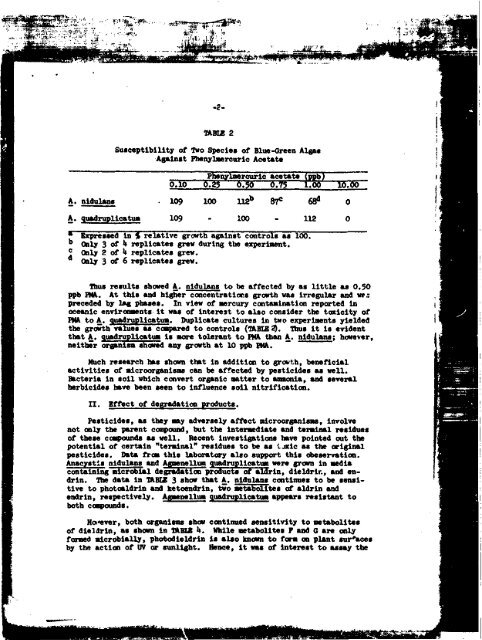Item ID Number - Special Collections
Item ID Number - Special Collections
Item ID Number - Special Collections
You also want an ePaper? Increase the reach of your titles
YUMPU automatically turns print PDFs into web optimized ePapers that Google loves.
-2-<br />
TABIE 2<br />
A. nidulans<br />
A. quadruplicatum<br />
Susceptibility of Two Species of Blue-Green Algae<br />
Against Fhenylmercuric Acetate<br />
0.10<br />
. 109<br />
109<br />
Phenylmercuric acetate<br />
0.25 0.50<br />
100 112 to<br />
100<br />
PPb)<br />
0.75 1L.OO<br />
87° 68*<br />
Expressed in % relative growth against controls as 100.<br />
Only 3 of U replicates grew during the experiment.<br />
*? Only 2 of k replicates grew.<br />
Only 3 of 6 replicates grew.<br />
112<br />
10.00<br />
0<br />
0<br />
Thus results showed A. nldulans to be affected by as little an 0.50<br />
ppb PMA. At this and higher concentrations growth was irregular and vts<br />
preceded by lag phases. In view of mercury contamination reported in<br />
oceanic environments it was of interest to also consider the toxicity of<br />
FHA to A. quadruplieatum. Duplicate cultures in two experiments yielded<br />
the growth values as compared to controls (TABLE! 2). Thus it is evident<br />
that A. quadruplicatum is more tolerant to FMA than A. nldulans; however,<br />
neither organism showed any growth at 10 ppb IMA. ~~<br />
Much research has shown that in addition to growth, beneficial<br />
activities of microorganisms can be affected by pesticides as well.<br />
Bacteria in soil which convert organic matter to ammonia, and several<br />
herbicides have been seen to influence soil nitrification.<br />
II. Effect of degradation products.<br />
Pesticides, as they may adversely affect microorganisms, involve<br />
not only the parent compound, but the intermediate and terminal residues<br />
of these compounds as well. Recent investigations have pointed out the<br />
potential of certain "terminal" residues to be as Ijxic as the original<br />
pesticides. Data from this laboratory alco support this obeservation.<br />
Anacystis nidulans and Agmenellum quadruplieatum were grown in media<br />
containing microbial degradation products of aldrin, dieldrln, and endrin.<br />
The data in TABIE 3 show that A. nldulans continues to be sensitive<br />
to photcaldrln and ketoendrin, two metabolites of aldrin and<br />
endrln, respectively. Agmenellum quadruplicatum appears resistant to<br />
both compounds.<br />
However, both organisms show continued sensitivity to metabolites<br />
of dieldrin, as shown in TABI£ U. While metabolites P and G are only<br />
formed microbially, photodieldrin is also known to form on plant surfaces<br />
by the action of UV or sunlight. Hence, it was of interest to assay the
















